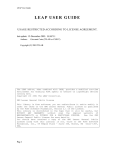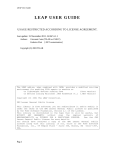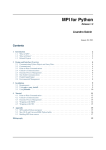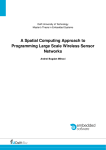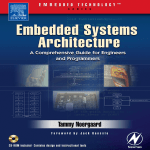Download JOPI: Java Object-Passing Interface
Transcript
University of Nebraska-Lincoln
Computer Science and Engineering
JOPI: Java Object-Passing Interface
User’s Guide
Date
Version
February 20, 2004
1.0.0 (Beta)
Prepared by
Jameela Al-Jaroodi &
Nader Mohamed
JOPI: The Java Object-Passing Interface
User’s Guide
Table of Contents
1. Introduction
2. MPI Vs. JOPI
3. JOPI API
Attributes
Methods
1. Synchronous (blocking) point-to-point operations
2. Synchronous (blocking) group operations
3. Asynchronous (non-blocking) point-to-point operations
4. Support operations
Example
4. Compiling and Running Programs
5. Error Messages
6. Example JOPI Program
Summation of numbers in a list
Acknowledgements
Index
2
3
5
5
6
6
7
8
9
10
12
15
17
17
21
21
1
JOPI: The Java Object-Passing Interface
User’s Guide
1. Introduction
Clusters require system and software services that can support the distributed architectures
and provide transparent and efficient utilization of the multiple machines available. In
addition, Java is becoming a good option for developing high performance and distributed
applications on clusters. We introduce an infrastructure for a parallel programming
environment in Java. The system provides Java programmers with the necessary functionality
to write object-passing parallel programs in clusters. The main features of JOPI are: (1) It is
suitable for clusters and distributed heterogeneous systems, (2) It utilizes the object-oriented
programming paradigm for parallel programming thus simplifying the development process,
and (3) It is most suitable for large scale applications and applications with low
communication-to-computation ratio.
The Java object-passing interface (JOPI) provides an MPI- like interface that can be used to
exchange objects among processes. Using objects to exchange information is advantageous
because it facilitates passing complex structures and enables the programmer to isolate the
problem space from the parallelization problem. Software agents were used to provide the
necessary functionality on the participating processors. Users need not deal with the
mechanisms of deploying and loading user classes on the heterogeneous system nor to deal
with scheduling, controlling, monitoring, and running user jobs. In addition, users need not
deal with managing the system resources. Since this system is written completely in Java, it is
portable and can allow run programs in parallel across multiple heterogeneous platforms. A
number of experiments were conducted using this system to measure its performance. The
results gathered show that it is possible to gain good performance using this system and that
future potential for enhancements and optimizations are feasible.
This system provides an infrastructure for high performance computing in Java (parallel Java)
for clusters or heterogeneous systems. Software agents were used to provide the necessary
functions that support the JOPI on clusters and distributed environments. Some of the benefits
of using agents are: portability, expandability, flexibility, security, and resources
management. Using the Java Object Passing Interface (JOPI) provided, the programmer will
be able to write parallel programs that can run on multiple nodes of a cluster or network
where the agents reside. In addition, the system is written completely in standard Java and can
be used on any machine that has a Java virtual machine (JVM).
This document is a user guide for the system. It will provide information about how to use the
environment and how to write parallel Java programs using the JOPI class. Since the interface
provided is similar in some ways to standard MPI, we decided to include some information
about MPI first. The third section introduces the different methods and attributes of the JOPI
class and how to use them when writing the parallel programs. Then the next section talks
about the environment and the different commands available to run the parallel Java
programs.
2
JOPI: The Java Object-Passing Interface
User’s Guide
2. MPI Vs. JOPI
Object passing like message passing is a model of explicit parallel programming with the
following characteristics:
1) Multithreading: a message-passing program has multiple processes that have their own
control and may execute different code.
2) Asynchronous parallelism: processes execute asynchronously and require explicit
synchronization.
3) Separate address space: each process has its own address space and exchanges
information using special message-passing functions.
4) Explicit interaction: user must resolve all interaction issues such as communication,
synchronization, and aggregation.
5) Explicit allocation: workload and data must be explicitly allocated to processes by the
user.
6) logic Exchange: Object-passing allows processes to exchange codes (not just data),
which provides a flexible, scalable, and easy way to use the parallel environment.
The Message Passing Interface (MPI) is a library of routines provided for users who wish to
write parallel and distributed programs. MPI-1 was developed for use mainly with FORTRAN
and C language. It provides a number of library functions to exchange messages between
processes. It provides functions for point-to-point communication, group communications,
synchronization and others. Using MPI for parallel programming is not trivial. It requires the
programmer to be aware of almost all of the parallelization issues and details of the messages
to be exchanged. On the other hand this provides the programmer with high flexibility. MPI-1
can be used to exchange messages containing one data type such as integers, float or char. In
addition it allows packing and unpacking of data of different lengths or types. It also can
allow passing arrays and structures, but this requires a lot of coding.
Later MPI-1.2 and MPI-2 was developed as extensions of MPI-1 additional functionality such
as process creation and management, one-sided communications, extended collective
operations, external interfaces, I/O, and additional language bindings such as C++ bindings.
Object-Oriented MPI (OOMPI) was introduced a few years ago with the main concern to
provide C++ programmers with more abstract message passing methods.
JOPI provides similar functions using objects as a means of exchanging data and logic. This
provides users with the ability to encapsulate not just the data, but also the logic that uses that
data into a single object that can be then sent to other processes to be used there.
The object-oriented paradigm preserved in JOPI allows users to simplify the process of
writing parallel programs. The programmer here has the flexibility of using the available JOPI
methods to exploit the different properties to optimize the programs. Compared to the
standard MPI, JOPI allows the programmer to exchange objects instead of predefined data
3
JOPI: The Java Object-Passing Interface
User’s Guide
elements. This means that the programmer need not worry about the type or size of the
message to be sent. All that is required is to have all the data encapsulated within an object.
When using JOPI, the programmer needs to identify the problem and write the necessary code
to solve it sequentially. Then methods can be added to handle problem partitioning for a
parallel solution and to reconstruct the solution from the partial solutions computed by the
different processes. The parallelization process can then be easily done using the available
methods and the JOPI methods.
To support JOPI’s library functions, we included the following features in the agent-based
run-time infrastructure:
1) Providing mechanisms to load user programs onto the remote JVMs of the cluster
nodes and the machines used
2) Managing cluster resources and scheduling user jobs
3) Providing security measures to protect the user programs and the machines used
4) Providing job and thread naming to facilitate simultaneous multi- user and multi-job
executions and proper process identification
5) Providing user commands and control operations that facilitate job sub mission,
monitoring and control
4
JOPI: The Java Object-Passing Interface
User’s Guide
3. JOPI API
This part contains all the functions that provide the user with the Java parallel programming
object-passing interface. Using the functions in this class the user can send, receive and
broadcast objects. Please keep in mind that Java is case-sensitive thus JOPI is also casesensitive. Therefore, make sure to follow the proper syntax and letter-case for the methods
and attributes of JOPI.
The objects that are used in send and receive must be defined to implement Serializable (i.e.
they must be serializable for the system to be able to move them to remote processors).
Example:
class List_Class implements Serializable
In addition, other attributes to identify the process ID and number of processes are available.
Before using the methods available in JOPI class, like with any other Java classes, the user
must define an instance of the JOPI class for the program.
JOPI m p = new JOPI(String[] args)
Where args is the array of arguments passed to main and mp is the name of the instance
created from JOPI.
The following gives details of the methods and attributes in the JOPI class, which the user can
now use to write a parallel Java program. We will use the instantiated JOPI object mp
(defined above) in all our following examples for the sake of clarity. However, users are free
to select the names of their objects and the user-defined classes and attributes.
Attributes
A number of attributes are defined in the JOPI class that support parallel programming using
the object-passing model. The explicit communication requires the programmer to identify
individual processes and other supporting values. First the user needs to know the process
identification number of each processes used and the total number of processes in the
program. In addition, some general attributes are needed to issue general operations that do
not require specific values.
a. mp .myPI D. This field is an integer and contains the current process identification
number, which can be used in other methods such as send, receive, Isend,
Ireceive, etc.
b. mp .nprocs. This field is an integer and contains the number of processes in the
user job (program). This is necessary for workload distribution among participating
processes and for group communication and synchronization operations.
5
JOPI: The Java Object-Passing Interface
User’s Guide
c. JOPI.ANY_TAG. This is a static attribute that can be used as a wild card with the
receive operations such that it will accept an object with any tag value.
d. JOPI.ANY_CLASS. This is a static attribute that can be used as a wild card with the
receive operations such that it will accept an object of any class type.
e. JOPI.ANY_SOURCE. This is a static attribute that can be used as a wild card with
the receive operations such that it will accept an object from any source.
The static attributes are useful for receive operations where the tag, class type, and/or source
are not statically determined before run-time. For example if a process needs to accept the
first response that arrives from any one of multiple processes then it cannot specify the
source. As a result it uses the JOPI.ANY_SOURCE to accept any incoming object.
Methods
The JOPI class provides a number of methods for different operations in parallel and
distributed programming. Many of these support explicit exchange of objects among the
processes in synchronous and asynchronous modes.
1. Synchronous (blocking) point-to-point operations
a. send. This method sends an object from one process (thread) to another. When it is
used, it blocks the sending process until the message has reached its destination. The
user needs to specify the target process ID (pid), the object to be sent, and the tag. As
in standard MPI, the tag is used to pair send and receive operations to make sure the
receiving process receives the correct object.
mp . send (int pid, Object o b j, int tag)
Where pid and t a g are integers. Example: Assume we have an object called
greetings defined from a class Greetings_Class, then the following line will send the
object greetings to process number 2 with tag value 0.
mp .send(2, greetings, 0)
b. receive. This is a method used by a process to receive an object sent by another
process. The user can specify where the object is coming from (pid), The class name
(a string argument) that the object belongs to (className), and the tag (tag). The
user also has the choice to use JOPI.ANY_TAG, JOPI.ANY_CLASS, or
JOPI.ANY_SOURCE to receive an object with any tag value, of any class type, or
from any other process, respectively. This method blocks the receiving process until
the receive operation is complete and the object is in the receiver’s buffer. It always
returns an object (the received object). A cast for the class type of the object received
must be given to get the correct object format. Usua lly if className is given it
should be the same as class_type.
Obj_ref = (class_type) mp.receive(int pid, String className, int tag)
6
JOPI: The Java Object-Passing Interface
User’s Guide
This will receive an object from process pid with class type className and tag value
of tag. The user can also use JOPI.ANY_SOURCE, JOPI.ANY_CLASS, and/or
JOPI.ANY_TAG in place of pid, className, and/or tag respectively.
Examples:
Obj_ref = (class_type) mp.receive(JOPI .ANY_SOURCE,
JOPI.ANY_CLASS, JOPI.ANY_TAG)
This allows the receive method to accept any incoming message from any process, of
any class type and with any tag value.
Obj_ref = (class_type) mp.receive(4, JOPI.ANY_CLASS, 0)
This receives an object of any class type from process number 4 and with tag value 0.
greetings = (Greetings_Class) mp.receive(0,”Greetings_Class”, 0)
This will receive the object greetings sent by process 0.
(see the send example)
2. Synchronous (blocking) group operations
a. Bcast. This is a group communication method that allows one process to send an
object to all other processes. When broadcast is used, all processes will issue the Bcast
command. The sender will specify the object to be sent and all other processes will act
as receivers to get that object. Broadcast is blocking so the sending object will block
until the object is successfully sent, while each receiving process will wait until the
object is received in its buffer before continuing. There are two variations of the
broadcast method:
mp .Bcast(Object obj, int group_no)
Used by the sending process to broadcast the object o b j to the group identified by
group_no . ob j is a string and group_no is an integer.
Obj_ref = (class_type) mp.Bcast (int group_no)
Used by all other processes to receive the broadcast message the group number,
group_no , here must match the one specified by the sending process. This method
will return the received object. To receive the correct object it must be cast into the
proper class type using class_type .
b. barrier. This is a synchronization method used to synchronize a group of processes.
When the barrier method is invoked with a given number of processes, any process
reaching this method will suspend its execution and wait until the specified number of
processes reaches the barrier then they all can resume execution at the same time.
mp .barrier(int id, int no_procs)
Here the id (integer) is used to identify the barrier since many barriers may be issued
in a program. no_procs (integer) indicates the number of processes that must reach
the barrier before all of them can go on.
7
JOPI: The Java Object-Passing Interface
User’s Guide
3. Asynchronous (non-blocking) point-to-point operations
a. Isend. This method (like send) is used by a process to send an object to another
process. Here it allows the process to issue a send request and go back to its
computations without waiting for the send operation to complete. Later the process
can use the testIsend or waitIsend methods to check if the send operation was
completed. The method Isend will return a request identification number requestID
to be used for verifying the send completion. When a process issues an Isend
operation, it should not modify the object sent before making sure the operation has
completed using the testIsend or waitIsend methods. Otherwise, such changes may
affect the results of the execution since the data sent may not be the one intended.
RequestID = mp .Isend( i nt p id, Object obj, int tag)
b. Ireceive. This method (like receive) is used to receive an object from another
process. Here it allows the process to issue a request to receive an object and then
continue with its processing. Later the process can issue a testIreceive or
waitIreceive function to find if the receive request was fulfilled. This Ireceive will
return a request identification number r e q u e s t I D that can be used to check the
request.
RequestID = (class_type) mp.Ireceive(int pid,
String className, int tag)
This will issue a request to receive an object identified by className from a sender
identified by pid with a given tag value. As in blocking receive a cast must be given
for the object received. In addition, the static attributes JOPI .ANY_SOURCE,
JOPI.ANY_CLASS, and JOPI.ANT_TAG can be used just like with the send
method. When Ireceive is used, the object will not be available for use by the
process until the receive operation is completed. Therefore, it is necessary to check for
its completion before using the object.
c. testIsend. This is an asynchronous (non-blocking) method to check if an
asynchronous send operation (Isend) has completed. It uses the r e q u e s t I D to
identify the send operation to be checked. When testIsend is issued the system
checks if the request for send identified by the r e q u e s t I D has completed. It will
return true if completed and false if not.
SendFlag = mp .testIsend(int requestID)
This will check the send operation and return true if the requested send operation has
completed and false otherwise. SendFlag must be defined as Boolean.
d. testIreceive. This is an asynchronous (non-blocking) method to check if an
asynchronous receive operation (Ireceive) has completed. It uses the requestID to
identify the receive operation to be checked. When testIreceive is issued the system
checks if the request for receive identified by the requestID has completed. It will
return the received object if completed and Null if not.
Obj_ref = (class_type) mp.testIreceive(int requestI D
8
JOPI: The Java Object-Passing Interface
User’s Guide
This will check the receive operation and will return the received object in the
Obj_ref if the receive operation has completed and will return N u l l otherwise. Here
also a cast needs to be given for the object received. The programmer must check the
object to know if the receive operation has completed (test for Null) before trying to
use that object.
e. waitIsend. This is a synchronous (blocking) method to check for asynchronous (nonblocking) send operation completion. waitIsend will not return until the send
operation is completed. As in testIsend, it uses requestID to identify the operation to
be checked.
mp .wait Isend(int requestID)
This will check the send operation and only return if the requested send operation has
completed. An Isend followed immediately by waitIsend will be equivalent to using
the send method.
f. waitIreceive. This is a synchronous (blocking) method to check for the completion of
asynchronous (non-blocking) receive operation. waitIreceive will not return until the
receive operation is completed and the object is in the receive buffer. On return this
method will return the received object. As in testIreceive, it uses requestID to
identify the operation to be checked.
Obj_ref = (class_type ) m p.waitIreceive(int requested)
This will block the process until the object requested is received and will return that
object. Here also a combination of Ireceive followed immediately by waitIreceive is
equivalent to a synchronous receive method. A cast for the object received must be
given.
4. Support operations
a. receiveSource. This method is used after a successfully completed receive operation
to identify the source of the object received. This is mainly useful if the receive
operation used the JOPI.ANY_SOURCE attribute. This operation can follow the
receive, Ireceive, Bcast (at the receiving end), successful testIreceive (if object
returned is not Null), and waitIreceive methods. This method will return an integer
value representing the sending processor number. The result returned will correspond
to the last successfully completed receive operation only. The method cannot provide
information about other past receive operations.
Source_no = mp . receiveSource( )
b. receiveClass. This method is used after a successfully completed receive operation to
identify the class type of the object received. This is mainly useful if the receive
operation used the JOPI.ANY_CLASS attribute. This operation can follow the
receive, Ireceive, Bcast (at the receiving end), successful testIreceive (if object
returned is not Null), and waitIreceive methods. This method will return a string
which provides the class name the received object belongs to. The result returned will
9
JOPI: The Java Object-Passing Interface
User’s Guide
correspond to the last successfully completed receive operation only. The method
cannot provide information about other past receive operations.
Class _ name = m p. receiveClass( )
c. receiveTag. This method is used after a successfully completed receive operation to
identify the tag value associated with the received object. This is mainly useful if the
receive operation used the JOPI.ANY_TAG attribute. This operation can follow the
receive, Ireceive, Bcast (at the receiving end), successful testIreceive (if object
returned is not Null), and waitIreceive method. This method will return an integer
value representing the tag value associated with the object. The result returned will
correspond to the last successfully completed receive operation only. The method
cannot provide information about other past receive operations.
Tag_no = m p. receiveT a g()
d. print. This method is similar to the regular print methods in Java except that the
output is directed to the client station where the user job was initiated. This allows for
all screen output to be available on the user console. The format used in this method is
exactly the same as in the regular print method in Java.
mp .print (String msg)
e. close. This method is used at the end of the program to end the JOPI interface. Using
this method will ensure that the program will correctly exit and all processes related to
it will be terminated.
mp .close ()
Example
In the figure below we illustrate JOPI’s API usage (Please note that the line numbers are only
for illustration purposes and that they are not part of the program). This program simply sends
a message “Hello World” to all processes that will receive and print that message along with
the process identification number. In line 10 an instance of the JOPI class called mp is
instantiated. In line 11 mp.myPID is used to get the current process ID. Line 15 sends the
string object to other processes (String in Java is a serializable object; therefore it can be
directly sent using JOPI send method). In line 20 the other processes issue a receive to
receive the object. In this case we used JOPI.ANY_TAG and JOPI.ANY_CLASS to accept
any object with any tag value. In many other cases the user may need to explicitly specify the
class type and/or the tag.
Notice that it is possible to use broadcast method in this example to distribute the greeting
message to the processes. To do that all you need to do is replace lines 14 and 15 with the
following:
mp .Bcast(greeting, 1);
which will broadcast the string object to all other processes and line 20 by:
Greeting = (String) mp.Bcast(1);
10
JOPI: The Java Object-Passing Interface
User’s Guide
mp .barrier(int id, int No_procs)
which will first allow each process to receive the broadcast message and then wait until all
processes reach this point (making sure all received the message) before printing the message
and exiting.
1
2
3
import java.io.*;
import java.util.*;
import java.net.*;
4
5
6
7
8
9
10
11
12
13
14
15
16
17
18
19
20
21
22
23
24
25
public class Hello_1
// Main class
{
public static void main(String[] args)
{
int j;
String greeting;
JOPI mp = new JOPI(args);
// Instantiating a message passing object
if( mp.myPID == 0 )
// process 0
{
greeting = "Hello World";
for(j = 1; j < mp.nprocs; j++)
mp.send(j, greeting, 0);
mp.print(greeting+" I am process number "+mp.myPID);
}
else
// other processes
{
greeting = (String) mp.receive(0,JOPI.ANY_CLASS,JOPI.ANY_TAG);
mp.print(greeting+ " I am process number "+mp.myPID);
}
mp.close();
// Close message passing object
}
}
Example. A parallel JOPI program to print a greeting message from all processes.
11
JOPI: The Java Object-Passing Interface
User’s Guide
4. Compiling and Running Programs
When the program is complete, it should be compiled using javac like any other regular
Java program. Example, if the program name is prog1.java then compile as follows:
javac Hello_1.java
To run the program after successful compilation, the user needs to define a parallel job file.
This file is given a .pj extension and should contain the following information (see the
example below; please note that the line numbers are only for illustration purposes and that
they are not part of the file):
1. The name of the main class in the program preceded by the keyword M a i nC lass (line 1)
2. The keyword Classes followed by the names of all classes used in the program including
the main class (line 2).
3. The number of processors needed and how they are scheduled. The schedule for the
processes can be left to the system (using AutoSchedule option), in this case the user need
only specify the number of processes needed to run the program (line 3). Example:
AutoSchedule 6
This will make the system automatically create a schedule for six processes.
On the other hand, the user can specify his /her own schedule by listing the agents and number
of threads to run on each agent. Example:
Agent agent1
2
Agent agent2
1
Agent agent3
2
Agent is a keyword and agent1 , agent2 and agent3 are the names of the agents on the
machines used. These names are defined in the system (in the agents list file) and the user can
get a list of these names by using the command pingAgent . The integer number following
the agent name specifies how many threads should run on that machine. This sequence (may
replace line 3) means that two threads will run on the machine that has agent1 and the
machine that has agent3 on it and one thread will run on the machine that has agent2 on
it. The total number of threads (processes) here is 5.
The system allows multiple users to run multiple jobs at the same time. To properly manage
these jobs, each job has multiple levels of identification, starting with a unique j o b I D
assigned by the system. The u s e r I D and the program name further distinguish
different jobs. Within each job, t h r e a d I Ds are used to identify the remote threads of the
job. To protect user applications and the systems executing them, two modes of execution are
utilized: (1) Agent mode, which allows a process to access all available resources on local and
12
JOPI: The Java Object-Passing Interface
User’s Guide
remote machines, and (2) user mode, which allows access to the CPU and memory for
execution only on remote machines. With the security modes in place, the user processes have
full access to resources on their local machine (where the user job was initiated). In addition,
user processes have very limited access to all remote machines’ resources (since they are
running in user mode). To provide users with access to necessary resources for their
application, the root (master) process is forced to execute on the user’s local machine.
However, the user has the option to override this setting and execute the root process on a
remote machine, thus limiting its access to system resources.
The user can specify if root process should or should not run on the local machine (line 4 in
the example). NoLocal means that root process should not run on the local machine. If it is
not included, then the root process will run on the local machine.
When JOPI is first installed, the administrator may bypass the security restrictions thus
allowing user processes to have full access to all recourses on all the machines used. If this is
true, then the NoLocal option will not have much effect on resource access.
1
2
3
4
MainClass Hello_1
Classes Hello_1.class
AutoSchedule 4
NoLocal
Example: hello.pj file for the Hello_1.java program shown earlier. In this case the main class
is Hello_1 and it is the only class in the program. Automatic scheduling was selected and all
processes will run on remote machines.
When the .pj file is ready, the user can run the program using the following command:
p j a v a filename.pj
Example:
p j av a hello.pj
The client services class is the link between the user and the agents. It accepts requests from
the user, encapsulate the job and the necessary information into a request object, and passes it
to the agent. It also handless all the commands issued by the user such as pingAgent and
listThreads. A number of commands are ava ilable for the users through the client services:
a. p j a v a filename.pj è This command is used to initiate a user job (start execution
of the parallel program). This will deploy the user processes on the requested number
of processors and start running. When the user runs this command the client services
takes the user job along with all the necessary information to start that job and puts it
in an object. This object is then passed to the agents for deployment and execution. As
13
JOPI: The Java Object-Passing Interface
User’s Guide
shown earlier, the schedule used for running the user job can be specified by the user
or left to the scheduler to generate. For this command to work a user file *.pj must be
created to identify the user program classes and the schedule for running the program.
b. pingAgent [all] | [agentname] è This is used to list the available agent(s)
and their status (Active or I nactive) on the system. If an agent name is given the
status of that agent is checked and displayed. The all option will make the command
check all the agents and display the full list of agents. Not specifying any option will
default to all. The status of an agent is either Active indicating that it executing and
ready to accept user jobs or Inactive indicating that it is down and not available for
executing user jobs.
c. listThreads [all] | [agentname] è This is used to list all active threads on
the agent(s). The user can specify a specific agent or all agents to be checked. The
default option for this command is all. This command provides the following
information about each thread:
i. Agent : the agent on which the thread is running on
ii. J o b I D: the identification number of the job this thread belongs to
iii. User: the user this job belongs to
iv. Program: The name of the main class (program) that created this thread.
v. Pid : the identification number of the thread
vi. R. Time : the amount of time passed since the thread started execution.
d. testAgents è Used to report some performance features about the machines where
the agents are running. This command activates a small program on all agents and
measures the amount of time it takes each agent to complete that program. This gives
a relative measurement of how much load (or how fast) the agent can execute
programs. This is currently used by the scheduler to identify the fastest available
agents to schedule the jobs accordingly. It is also available for the users for testing
purposes.
e. killJob j o b I D è This is a command to terminate a given user job (like the kill
command in UNIX). The user needs to specify the j o b I D (can be found using
listThreads command) with the command. When a job is killed, all the threads that
belong to it will be terminated on all the machines originally executing this job.
14
JOPI: The Java Object-Passing Interface
User’s Guide
5. Error Messages
When compiling a program that uses JOPI, the syntax errors and standard Java errors will all
be identified by the Java compiler. However, there are other parts that are checked by the
JOPI run-time environment and may generate a different set of errors. We used unique
identifiers for these errors starting with two characters indicating the type of the error
followed by a three digit number for the error. Short error messages follow the identifier for
the user’s information. The following table lists the error messages and the possible actions
that can be done to resolve them. The errors are of three types:
1. PJxxx are errors concerning the .pj file. Generally these errors can be resolved by
checking the .pj file and making some corrections.
2. UPxxx are errors related to the user program. In most cases the exception messages
would help in identifying the source of the error.
3. SYxxx are system related errors. Many of these errors may require the help of the
JOPI administrator to resolve.
Error
Display Messages
Codes
PJ001 Agent <agent id> is not
defined in the agents list file
or inactive
PJ002
PJ003
PJ004
PJ005
Action
1. Check the agents and their status (active/inactive) using
pingAgent
2. Check agent names in your .pj file and make sure they
are spelled correctly and only active agents are used
Parallel Java file <file id> can 1. Check .pj file name
not be read
2. Make sure the file is accessible and in the right location
(verify the path settings)
Unknown command
1. Check spelling and syntax of the command indicated
<command line> in .pj file
Class <class name> could not 1. Make sure the class name is included correctly in the .pj
be loaded
file
2. Verify the class name spelling and case in the .pj file
Class file <file name> does
1. Make sure the class names listed in the .pj file are the
not exist
same as the ones used in your program
2. Make sure the class names are correct (names in .pj file
match the names in the source code)
3. Make sure the class is accessible and in the correct
location.
4. Check the path settings to your files
15
JOPI: The Java Object-Passing Interface
User’s Guide
Error
Display Messages
Codes
SY001 Agents list file <file name>
can not be read
SY004
SY005
SY006
UP001
Action
1. Make sure the agents file is available in its designated
location (physical file is calle d agents)
2. Make sure the path settings to the agents list file is
correct
3. Contact the system administrator if the file is not
available
Directory file <directory file> 1. Contact admin to verify the existence of this directory and
does not exist
make sure it is available and in the correct location
Timeout in send operation
1. Thread unable to send a message to destination before
timeout.
2. Check network connectivity between nodes
3. If persistent, report problem to admin. to check.
Receiving Thread Error
1. Report problem to admin. to check. However, admin
may not be able to solve this immediately.
Error in running user threads 1. Check your source code (in most cases there may be
(Java run-time error)
some exception messages displayed that can help
pinpoint the errors)
16
JOPI: The Java Object-Passing Interface
User’s Guide
6. Example JOPI Programs
Here we provide a full example of parallel Java programs written using JOPI. The code can be
easily extracted and compiled as a Java program. The .pj examples given here are specific to
the system we are using and may require changes (mainly the agent names and number of
processors used).
Summation of numbers in a list
Although not a very useful application, the following is a complete parallel program that
calculates the sum of the elements of a list. The class list C las s defines the methods and
attributes needed to create, divide and manipulate the list. The main class is responsible for
the parallelization process. Process 0 is the master process and it uses the methods in
listClass to divide the list into sub- lists, sends the sub- lists to other processes, calculates its
own sub- list and then receives and adds the sub sum values received from the other processes
and reports the final result. Each process including the master process will calculate the sub
sum of part of the list, print the partial result and send it back to process 0. The program also
calculates the time of execution using the system time method. JOPI can only send and
receive objects; therefore when an integer value was to be sent it was defined using the Java
Integer class. This way the subSumResult variable becomes an object of the class
Integer, which is serializable, and can be used by JOPI. Following is the full program code
followed by two versions of the job execut ion file and the steps of compiling and running the
program.
/*************************************************************************/
// The source code for the example program list1.java
import java.io.*;
import java.util.*;
import java.net.*;
public class list1
// Main class
{
public static void main(String[] args)
{
int MAX_SIZE = 6000;
//Maximum size of the list
int RANGE_FROM = 1;
//Minimum value of an element
int RANGE_TO = 10;
//Maximum value of an element
int i, j, load, sumValue;
long startTime=0,endTime=0,diff=0;
JOPI mp = new JOPI(args);
//Instantiating a JOPI object
Integer subSumResult;
//Defining an Integer object
listClass fullList, partList; //defining a list objects
if( mp.myPID == 0 )
// process 0
{
fullList = new listClass(MAX_SIZE, RANGE_FROM, RANGE_TO);
load = MAX_SIZE / mp.nprocs; //Size of sublists
mp.print("Process load = "+load);
startTime = System.currentTimeMillis();
17
JOPI: The Java Object-Passing Interface
User’s Guide
for(j=1; j<mp.nprocs; j++)
//Repeat for all processes
{
//Make a sublist of the original list
partList = fullList.subList(j*load, (j*load)+load-1);
//Send the sublist to process j
mp.send(j,partList,0);
}
//Process 0 also works on a sublist
partList = fullList.subList(0, load-1);
sumValue = partList.sum();
mp.print("Process "+mp.myPID+" sub sum = "+sumValue);
for (j=1; j < mp.nprocs; j++) //Repeat for all processes
{
//Receive sublist sum and add to overall sum sumValue
subSumResult =(Integer) mp.receive(j,JOPI.ANY_CLASS,1);
sumValue += subSumResult.intValue();
}
// Register end time and calculate and print total time
endTime = System.currentTimeMillis();
diff = endTime - startTime;
mp.print("List sum = "+sumValue);
mp.print("Time taken = "+diff);
}
else
// Other processes
{
//Receive sublist from process 0
partList = (listClass) mp.receive(0, JOPI.ANY_CLASS, 0);
//Calculate and send the sum to process 0
int subSum = partList.sum();
mp.print("Process "+mp.myPID+" sub sum = "+subSum);
subSumResult = new Integer( subSum );
mp.send(0, subSumResult, 1);
}
mp.close();
// Close message passing object
}
}
class listClass implements Serializable
{
public int size;
public int[] list;
public listClass(int tsize)
{
size = tsize;
list = new int[tsize];
}
// Problem class
public listClass(int tsize,int fromNo,int toNo)
{
int i;
size = tsize;
list = new int[tsize];
Random r = new Random();
for(i=0;i<size;i++)
list[i] = r.nextInt(toNo-fromNo+1) + fromNo;
}
public listClass subList(int fromPos,int toPos) // Sub-Problem method
18
JOPI: The Java Object-Passing Interface
User’s Guide
{
listClass t = new listClass(toPos-fromPos+1);
System.arraycopy(list,fromPos,t.list,0,toPos-fromPos+1);
return (t);
}
public int sum()
// Problem Solution method
{
int i;
int result = 0;
for(i=0;i<size;i++)
result += list[i];
return( result );
}
}
/*************************************************************************/
To compile the program:
$ javac list1.java
The contents of lista.pj:
MainClass list1
Classes list1.class listClass.class
AutoSchedule 5
NoLocal
To run the program:
$ pjava lista.pj
Output:
=============================================
Reading the parallel java job file
Loading user classes
Implementing job schedule
Starting Job ID 20351 with 5 threads
Running 2 threads at agent agent5
Running 2 threads at agent agent2
Running 1 threads at agent agent1
=============================================
[0]: Process load = 1200
[1]: Process 1 sub sum = 6426
[2]: Process 2 sub sum = 6664
19
JOPI: The Java Object-Passing Interface
User’s Guide
[3]:
[0]:
[4]:
[0]:
[0]:
Process 3 sub sum = 6672
Process 0 sub sum = 6616
Process 4 sub sum = 6790
List sum = 33168
Time taken = 36
A different run of the same program:
The contents of listb.pj:
MainClass list1
Classes list1.class listClass.class
Agent agent1 2
Agent agent2 2
Agent agent5 1
NoLocal
To run the program:
$ pjava listb.pj
Output:
=============================================
Reading the parallel java job file
Loading user classes
Starting Job ID 87243 with 5 threads
Running 2 threads at agent agent1
Running 2 threads at agent agent2
Running 1 threads at agent agent5
=============================================
[0]: Process load = 1200
[1]: Process 1 sub sum = 6657
[2]: Process 2 sub sum = 6630
[3]: Process 3 sub sum = 6735
[0]: Process 0 sub sum = 6553
[4]: Process 4 sub sum = 6654
[0]: List sum = 33229
[0]: Time taken = 40
The first six lines of the output are general information to show the user what is happening
and where the program threads are going to execute. The rest of the lines are the result of the
mp .print statements in the program. The number between the square brackets is added to
show which process initiated the print statement.
20
JOPI: The Java Object-Passing Interface
User’s Guide
Acknowledgements
This project was partially supported by a National Science Foundation grant, Nebraska
University Foundation grant, and the Priority Initiative in Simulation and Modeling grant.
This project was supervised by Dr. Hong Jiang and Dr. David Swanson, UNL.
Please note: If you find any errors or typos, please send an e-mail to
[email protected]
Index
Bold Page number is most significant mention of keyword
. p j ..........................................................................................................................................................................12, 13, 14, 15
A g e n t ...........................................................................................................................................................12, 14, 15, 18, 19
Asynchronous (non-blocking) point-to-point operations .........................................................................................2, 8
Attributes ...............................................................................................................................................................................2, 5
A u t o S c h e d u l e ...................................................................................................................................................... 12, 18, 19
barrier.............................................................................................................................................................................7, 8, 11
Bcast ......................................................................................................................................................................... 7, 9, 10, 11
C l a s s e s ..................................................................................................................................................................... 12, 18, 19
close....................................................................................................................................................................................10, 17
Clusters........................................................................................................................................................................................3
Error Codes.............................................................................................................................................................................15
Error Messages ......................................................................................................................................................................14
heterogeneous system...............................................................................................................................................................3
Ireceive........................................................................................................................................................................6, 8, 9, 10
Isend .................................................................................................................................................................................. 6, 8, 9
Java ..............................................................................................................................................................................................3
javac ...................................................................................................................................................................................11, 18
J o b I D......................................................................................................................................................................................14
JOPI (Java Object-Passing Interface)............................................................3, 4, 5, 6, 7, 8, 9, 10, 11, 13, 14, 15, 16, 17
JOPI.ANY_CLA SS...................................................................................................................................................6, 7, 8, 10
JOPI.ANY_SOURCE .............................................................................................................................................................6
JOPI.ANY_TAG............................................................................................................................................................... 7, 10
JVM (Java Virtual Machine)...................................................................................................................................................3
k i l l J o b ....................................................................................................................................................................................14
l i s t T h r e a d s ..................................................................................................................................................................13, 14
M a i n C l a s s ....................................................................................................................................................................12, 18
Methods ......................................................................................................................................................................................6
mp.............................................................................................................................................5, 6, 7, 8, 9, 10, 11, 16, 17, 19
MPI .................................................................................................................................................................................2, 3, 4, 6
MPI-1...........................................................................................................................................................................................4
MPI-2...........................................................................................................................................................................................4
21
JOPI: The Java Object-Passing Interface
User’s Guide
myPID....................................................................................................................................................................6, 10, 16, 17
N o L o c a l................................................................................................................................................................... 13, 18, 19
nprocs.................................................................................................................................................................................. 6, 16
OOMPI ........................................................................................................................................................................................4
p i n g A g e n t ............................................................................................................................................................. 12, 13, 15
pjava............................................................................................................................................................................ 13, 18, 19
PJxxx .........................................................................................................................................................................................14
print...............................................................................................................................................................10, 11, 16, 17, 19
receive ............................................................................................................................................5, 6, 7, 8, 9, 10, 11, 16, 17
receiveClass............................................................................................................................................................................10
receiveSource...........................................................................................................................................................................9
receiveTag..............................................................................................................................................................................10
send..........................................................................................................................................5, 6, 7, 8, 9, 10, 15, 16, 17, 20
Serializable .......................................................................................................................................................................... 5, 17
Support operations..............................................................................................................................................................2, 9
Synchronous (blocking) group operations....................................................................................................................2, 7
Synchronous (blocking) point-to-point operations.....................................................................................................2, 6
SYxxx........................................................................................................................................................................................14
t e s t A g e n t s ...........................................................................................................................................................................14
testIreceive....................................................................................................................................................................8, 9, 10
testIsend................................................................................................................................................................................8, 9
UPxxx........................................................................................................................................................................................14
waitIreceive..................................................................................................................................................................8, 9, 10
waitIsend..............................................................................................................................................................................8, 9
22

























